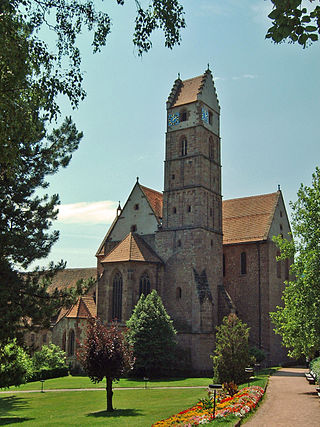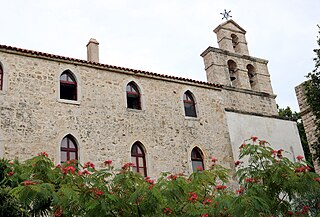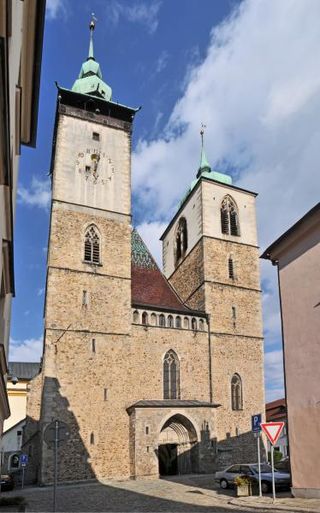
In Eastern Christianity, an iconostasis is a wall of icons and religious paintings, separating the nave from the sanctuary in a church. Iconostasis also refers to a portable icon stand that can be placed anywhere within a church. The iconostasis evolved from the Byzantine templon, a process complete by the 15th century.

The Bachkovo Monastery of the Dormition of the Theotokos, archaically the Petritsoni Monastery or Monastery of the Mother of God Petritzonitissa is a major Eastern Orthodox monastery in Southern Bulgaria. It is located on the right bank of the Chepelare River, 189 km from Sofia and 10 km south of Asenovgrad, and is directly subordinate to the Holy Synod of the Bulgarian Orthodox Church. The monastery is known and appreciated for the unique combination of Byzantine, Georgian and Bulgarian culture, united by the common faith.

Šajkaška (Шајкашка) is a historical region in northern Serbia. It is the southeastern part of Bačka, located in the Autonomous Province of Vojvodina. The territory of Šajkaška is divided among four municipalities: Titel, Žabalj, Novi Sad, and Srbobran. The historical center of Šajkaška is Titel.

Alpirsbach Abbey is a former Benedictine monastery and later Protestant seminary located at Alpirsbach in Baden-Württemberg, Germany. The monastery was established in the late 11th century and possessed considerable freedoms for an ecclesiastical property at that time, but in the 13th century it became a de facto possession of the Dukes of Teck and then the County of Württemberg. In the 15th century, the monastery enjoyed economic prosperity and was expanded but was dissolved with the conversion of the by-then Duchy of Württemberg to Lutheranism in the 16th century. The monastery became a seminary and boarding school until the 17th century and was physically reduced over the 19th century by land sales and demolition. Over the second half of the 20th century, the monastery was turned into a cultural fixture with annual concerts of Classical music and a museum of its history.

Dimitrije "Mita" Avramović was a Serbian writer, iconographer, caricaturist and painter in the Neoclassical style, considered to be the preeminent painter of the era and best known for his iconostasis and frescos. Avramović also translated from German into Serbian Johann Joachim Winckelmann's Geschichte der Kunst des Alterthums and other writings. He is considered the father of modern comic strips in Serbia. His caricatures were used to fight against the authoritarian rule of the masses in both the Austrian Empire and the Ottoman Empire at the time.

Ráckeve is a town on Csepel Island in the county of Pest County, Hungary. Its residents are mainly Magyars, with a minority of Serbs.

The Cathedral Church of the Holy Great-Martyr George is the seat of the Serbian Orthodox Eparchy of Bačka, located in Novi Sad, northern Serbia. The present-day church was completed in 1905, on the ruins of a church built in 1734 and destroyed in 1849. It is located next to the Eparchy offices in the Bishop's Palace, in Nikola Pašić Street. It is commonly known as Saborna crkva among the city residents.

The Krupa Monastery is a Serbian Orthodox monastery on the Krupa River in Croatia. It is one of the oldest Orthodox monasteries in Croatia, alongside Krka and Dragović monasteries.

The Cathedral of Hajdúdorog, officially Greek Catholic Cathedral of the Presentation of Mary in Hajdúdorog is the cathedral of the Archeparchy of Hajdúdorog, Hungary. This status ranks the cathedral among the most important buildings of the Hungarian Greek Catholic Church. The origins of the current cathedral reaches back to 1312, when historical notes mention that a church existed in the medieval settlement of Dorogegyháza. However, the present building has 17th century foundations, and it went through several building extensions and renovations during its history. The latest restoration were completed in 2006.
Dimitrije Bačević (1735–1770) was a Serbian icon painter and muralist in the Baroque style.

The Barnovschi Church is a Romanian Orthodox church located at 26 Ghica Vodă Street in Iași, Romania. It is dedicated to the Dormition of the Mother of God and to Saints Joachim and Anna.

The Church of the Birth of the Virgin Mary is a Serbian Orthodox Church located in the center of the Zemun district in Belgrade.

The Agia Triada Monastery is a Greek Orthodox monastery dedicated to the Holy Trinity, on the southwestern slopes of Mount Olympus, Greece, near the village of Sparmos, whence it is also commonly known as Sparmou Monastery. Beside the monasteries Agios Dionysios and Kanalon it is one of the monasteries located at Mount Olympus.

The Church of St. James the Great is an early Gothic church in Jihlava in the Czech Republic. It is a three-aisled temple nave with a long presbytery and two high towers in the front. It is consecrated to the patron of miners Saint James the Great.

Church of St. Nicholas in Pačetin is Serbian Orthodox church in eastern Croatia. The church is dedicated to St. Nicholas.

Nikola Aleksić was a Serbian artist. He was under the influence of the painting styles of the Nazarene movement and Biedermeier.
Pavle Simić was one of the most significant artists during the Serbian Romantic era.
Simeon Lazović was a Montenegrin Serb painter and one of the most famous icon painters of his time in the Balkans.

The Cathedral of the Dormition of the Theotokos in Szentendre, Hungary is the main and largest among Serbian Orthodox churches in Szentendre. The building is located within the fenced area of the episcopal palace and the Serbian Orthodox Ecclesiastical Art Museum, surrounded by veteran trees. The church's bell tower, located on the main façade, is 48 meters high, making it the tallest tower in Szentendre.

The cultural heritage management city parish church of St. Martin in Memmingen is one of the oldest churches in Upper Swabia. The church is a landmark of the city and is located on the edge of the northwestern old town, in the old Protestant church district in front of the old abandoned cemetery on a rise of the Memminger Achtal. Its tower is visible from afar and, at about 65 meters, is the tallest building in the city.



















